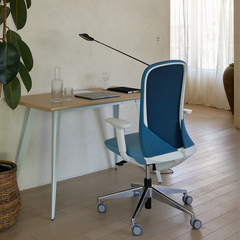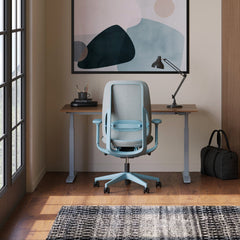Get 10% off your first order
Find the office furniture that’s designed to match your style, comfort, and needs perfectly. Subscribe
Work That Flows: Designing a Home Office That Actually Works

Visit quiz page to see how we makes it easy to create an inspiring workplace


Working remotely has changed the way we think about furniture. It’s no longer just about comfort or style—it’s about performance. The layout, materials, and structure of your workspace quietly shape your routines, energy, and mindset.
The right design supports not only how you work but how you feel while doing it. Let’s explore how furniture choices help shape better habits, productivity, and well-being in a remote setting.
The physical structure of your workspace influences how consistently you show up for work. A well-arranged desk area creates mental boundaries that separate work time from personal time.
Place your desk away from relaxation zones.
Keep tools organized and within reach.
Use natural light to signal work hours.
Clear your workspace at the end of each day.
Your layout sets the rhythm for your daily workflow and focus.
Long hours of stillness can lead to fatigue and lack of motivation. Modern furniture design encourages movement as part of the workday.
A flexible solution like the Small Standing Desk Iowa promotes posture variation and steady energy throughout the day.
|
Habit |
Frequency |
Benefit |
|
Stand and stretch |
Every 30 minutes |
Improves circulation |
|
Adjust desk height |
Every 1–2 hours |
Keeps muscles active |
|
Walk between calls |
3–5 minutes |
Boosts creativity |
|
Shift posture |
As needed |
Prevents stiffness |
Movement adds rhythm to your work and helps maintain focus without burnout.
Furniture isn’t passive—it guides how you interact with your environment. A comfortable chair invites long focus sessions, while an adjustable desk encourages motion.
Smooth surfaces invite writing and note-taking.
Rounded edges encourage relaxed posture.
Defined layouts reduce decision fatigue.
Storage keeps distractions out of sight.
Good design reinforces productive habits without you even noticing.
A workspace doesn’t need to be filled—it needs to be thoughtful. Every piece of furniture should contribute to comfort and flow, not clutter.
A simple standing desk combines structure and freedom, allowing you to move seamlessly through your day.
Keep accessories minimal to avoid sensory overload.
Choose neutral colors that calm the mind.
Prioritize ergonomics over decoration.
Ensure balance between softness and support.
A comfortable environment sharpens both focus and creativity.
Touch affects emotion. Natural textures like wood or fabric provide grounding and warmth, while metal and glass evoke focus and clarity.
|
Material |
Feel |
Ideal Use |
|
Wood |
Warm and grounding |
Desktops and storage |
|
Metal |
Sleek and structured |
Frames and bases |
|
Fabric |
Soft and cozy |
Seating |
|
Matte finishes |
Calming |
Accessories or lighting |
Mixing textures keeps your space dynamic yet peaceful.
According to workplace design studies, ergonomic furniture doesn’t just prevent pain—it boosts productivity. Proper support allows your brain to focus on work instead of discomfort.
Ergonomic setups increase efficiency by up to 15%.
Comfortable seating reduces stress and fatigue.
Proper desk height improves focus span.
Movement-friendly design promotes motivation.
Your comfort is the foundation of sustainable productivity.

Your furniture layout impacts how your brain interprets your workspace. Organized, symmetrical environments create calm and control, while messy ones trigger distraction.
Symmetry builds stability.
Open space invites creativity.
Natural elements restore mental clarity.
Defined zones improve task focus.
The right design supports not just productivity—but mental balance too.
Visual appeal isn’t just decoration; it’s motivation. A workspace that looks intentional encourages discipline and pride in your work.
A minimal office desk design maintains simplicity while complementing any style.
Keep a neutral color base with small accent tones.
Align objects by size for balance.
Maintain one visual focal point.
Avoid cluttered décor that distracts.
Beauty enhances usability when form and function are balanced.
When two or more people share a workspace, design must balance privacy and connection. A quad workstation layout supports shared collaboration while maintaining personal focus.
|
Element |
Tip |
Benefit |
|
Dividers |
Soft or low-height |
Maintains openness |
|
Lighting |
Even distribution |
Reduces shadow fatigue |
|
Storage |
Shared but organized |
Prevents clutter |
|
Seating |
Adjustable |
Fits different users |
Collaborative work thrives in structured yet flexible environments.
Your environment silently trains your behavior. Design elements like placement, symmetry, and repetition cue your brain to form habits.
Keep your workspace visible during work hours.
Use wall décor to set focus reminders.
Group tools by function for routine building.
Add a single plant to mark your “start zone.”
Good design helps habits grow naturally through rhythm and visual balance.

Remote work is here to stay, so it’s worth investing in furniture that adapts over time. Adjustable height desks and supportive chairs evolve as your habits and needs change.
Choose timeless materials over trendy ones.
Prioritize durability in high-use areas.
Look for flexible configurations.
Select designs that blend with both work and home life.
Adaptable design keeps your workspace relevant and supportive for years to come.
Furniture shapes habits—quietly, daily, and over time. The design you choose influences how often you move, how well you focus, and how comfortable you feel while working remotely.
Design affects both posture and mindset.
Comfort creates consistency.
Structure encourages motivation.
Flexibility fuels creativity.
The best furniture doesn’t just look good—it helps you live and work better. When your space aligns with your goals, focus becomes effortless and habits feel natural.

Work That Flows: Designing a Home Office That Actually Works

Choosing a Chair for Hardwood or Tile Floors

Gaming vs Executive Chairs for Remote Workers
Get 10% off your first order
Find the office furniture that’s designed to match your style, comfort, and needs perfectly. Subscribe
Leave a comment